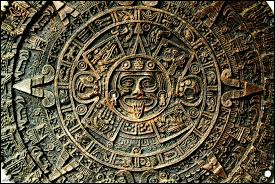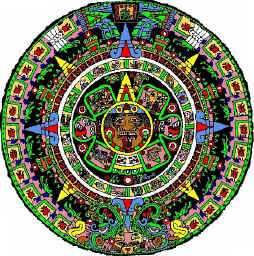The Aztecs used two different calenders, one measured time, while the other was used to fix religious festivals. The time-measuring calender was used to fix the best time for planting crops, while the religious calender told when to consult the gods.

In the time-measuring calender, one year had 365 days divided into 18 months. Each month had 20 days, and there were 5 extra days at the end of the year, which were thought to be bad-luck days when disasters were most likely to happen. The fundamental Aztec calender, the religious calender, was a 260-day cycle, called the tonalpohualli, or the "count of days."
Azec Sacred Calender
The tonalpohualli, or day-count, has been called a sacred calendar because its main purpose is that of a divinatory tool. It divides the days and rituals between the gods. For the Aztec mind this is extremely important.
Without it the world would soon come to an end. According to Aztec cosmology, the universe is in a very delicate equilibrium. Opposing divine forces are competing for power. This equilibrium is in constant danger of being disrupted by shifting powers of the gods, of the elemental forces that influence our lifes. This struggle cannot be won by any god.

The notion that everything ultimately consists of two opposing forces is essential to the Aztec worldview. The world is always on the brink of going under in a spiritual war, a war of gods competing for supreme power. To prevent this from happening, the gods have been given their own space, their own time, their own social groups, etcetera, to rule over. The tonalpohualli tells us how time is divided among the gods.
Azec Time measuring Calender
Where the Aztec differed most significantly from the Maya was in their more primitive number system and in their less precise way of recording dates. Normally, they noted only the day on which an event occurred and the name of the current year.
This is ambiguous, since the same day, as designated in the way mentioned above, can occur twice in a year. Moreover, years of the same name recur at 52-year intervals, and Spanish colonial annals often disagree as to the length of time between two events.
Aztec Calendar Facts
Other discrepancies in the records are only partially explained by the fact that different towns started their year with different months. The most widely accepted correlation of the calendar of Tenochtitlan with the Christian Julian calendar is based on the entrance of Cortez into that city on November 8, 1519, and on the surrender of Cuauhtzmoc on August 13, 1521.
According to this correlation, the first date was a day 8 Wind, the ninth day of the month Quecholli, in a year 1 Reed, the 13th year of a cycle.

The Mexicans, as all other Meso-Americans, believed in the periodic destruction and re-creation of the world. The "Calendar Stone" in the Museo Nacional de Antropologia (National Museum of Anthropology) in Mexico City depicts in its central panel the date 4 Ollin (movement), on which they anticipated that their current world would be destroyed by earthquake, and within it the dates of previous holocausts: 4 Tiger, 4 Wind, 4 Rain, and 4 Water.
|





